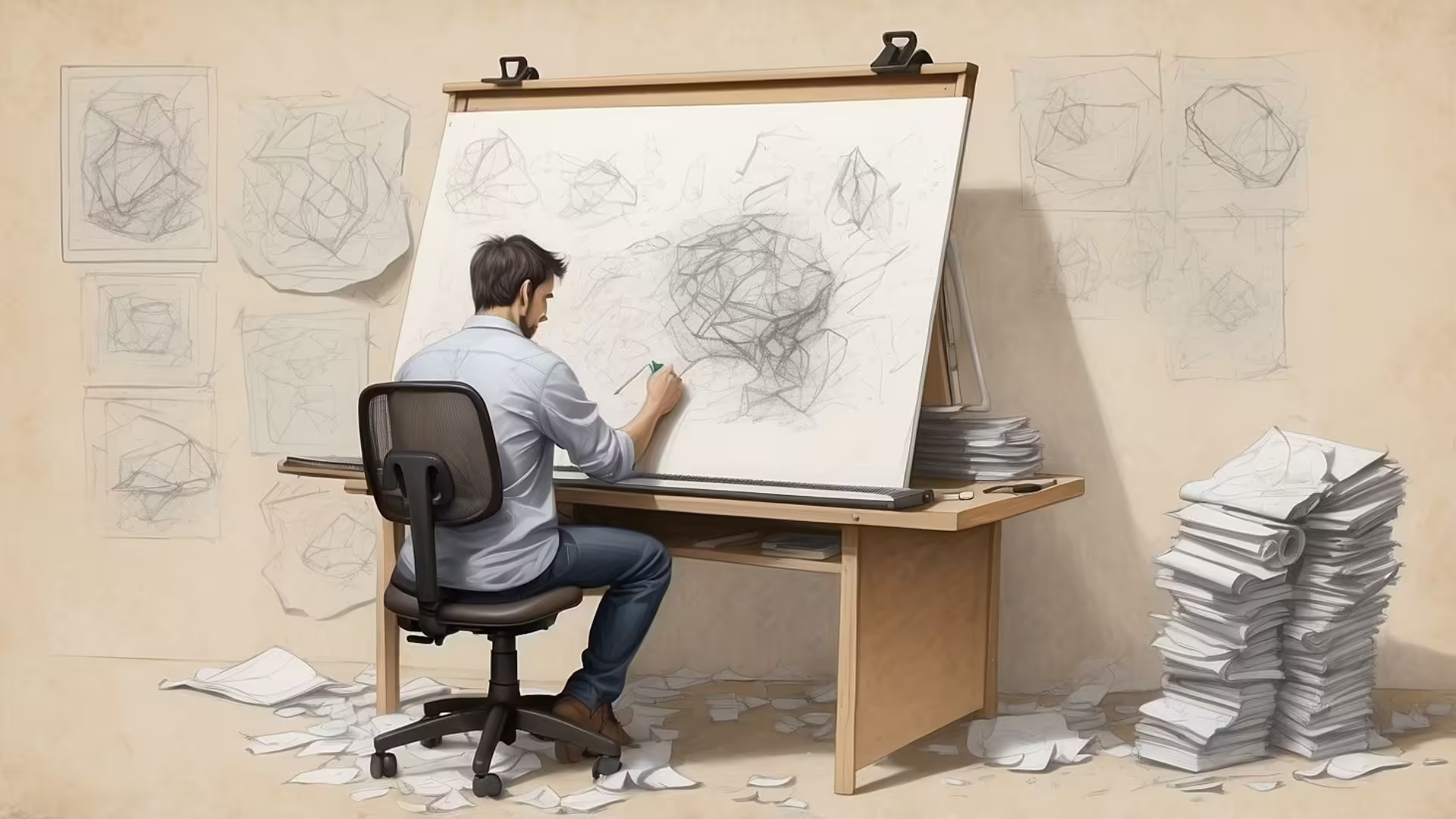- The Gist
- Back to the Drawing Board: Meaning, Usage, and Real-Life Examples
- What Does “Back to the Drawing Board” Mean?
- The Origin of the Phrase
- How to Use “Back to the Drawing Board” in Real Life
- Real-Life Examples of Going Back to the Drawing Board
- Why Going Back to the Drawing Board Is Important
- Let’s Talk
- Let’s Learn Vocabulary in Context
The Gist
Back to the Drawing Board: Meaning, Usage, and Real-Life Examples
The phrase “back to the drawing board” is commonly used when a plan, design, or idea has failed, and there’s no other option but to start over. Whether you’ve just launched a new project at work, planned an event, or tried to solve a problem, sometimes things don’t go as expected. And when that happens, it’s time to go back to the drawing board.
What Does “Back to the Drawing Board” Mean?
The expression essentially means to start over from scratch after a failure or setback. You’re going back to the planning stage to rethink your approach. It’s often used in situations where something didn’t work out, and you need to re-evaluate your strategy. The phrase implies that the original plan didn’t succeed, and now it’s time for a fresh start.
The Origin of the Phrase
The phrase originated in the world of design and engineering, where plans and blueprints are literally drawn out on a board. If a design didn’t work, the designer would have to “go back to the drawing board” to create a new one. The expression gained popularity after World War II, thanks to a cartoon by Peter Arno published in The New Yorker. In the cartoon, a plane crashes, and a designer walks away saying, “Well, back to the drawing board.”
Since then, the phrase has become widely used beyond design, applying to any situation where plans fall apart and a new approach is needed.
How to Use “Back to the Drawing Board” in Real Life
You’ll hear this expression in a variety of contexts, from casual conversations to formal business discussions. Here are some ways it might come up:
- Workplace Challenges: Imagine you’ve been working on a project for weeks, but your client rejects the idea. Instead of giving up, you and your team decide to go back to the drawing board, come up with new solutions, and try again.
- Personal Goals: Let’s say you’ve been trying to stick to a fitness routine, but it’s not working for you. You might say, “This workout plan isn’t giving me the results I want. Time to go back to the drawing board and find a new approach.”
- Creative Endeavors: If you’re a writer or artist working on a project that just isn’t coming together, you might scrap the current version and go back to the drawing board to start fresh.
The phrase is also used when things don’t go as planned in everyday life. Maybe you’ve tried to organize an event, and something goes wrong. When your plans fall apart, it’s time to rework your approach and go back to square one.
Real-Life Examples of Going Back to the Drawing Board
One famous example of going back to the drawing board is the development of the iPhone. Before the iPhone was created, many different prototypes were tested and rejected. Apple’s engineers had to go back to the drawing board multiple times before they created the sleek, touch-screen phone we all know today. That’s a perfect case of rethinking an idea and starting over until it succeeds.
In sports, athletes often go back to the drawing board after a loss. A football team might revise its strategy after a tough defeat, analyzing what went wrong and planning new tactics for the next game.
Why Going Back to the Drawing Board Is Important
The phrase carries a deeper lesson about resilience and problem-solving. It’s easy to get frustrated when things don’t go as planned, but going back to the drawing board shows the importance of adapting and finding new solutions. Whether you’re tackling a personal project or a professional one, setbacks are part of the journey. The key is to learn from those setbacks, rethink your approach, and try again.
Instead of seeing failure as the end, “back to the drawing board” reminds us that starting over can lead to better outcomes. It’s about persistence and the willingness to rethink what didn’t work. In a world that’s constantly changing, being able to pivot and adapt is essential for success.
Next time something doesn’t go according to plan, remember: it’s not the end, just time to go back to the drawing board. Whether you’re working on a new project, rethinking a strategy, or simply trying to solve a problem, starting fresh can open the door to new possibilities. So, how will you approach your next setback? Will you see it as a failure or a chance to try again with a new perspective? Let’s explore that together!
Let’s Talk
So, we’ve talked about going “back to the drawing board” when things don’t go as planned, but let’s be real for a second—how often does life actually go exactly how we imagined it? Probably not too often, right? That’s why this phrase is so useful. It’s not just about starting over; it’s about accepting that the path to success isn’t always a straight line. Sometimes, it’s full of twists, wrong turns, and maybe even a few crash landings.
What’s interesting is that going back to the drawing board isn’t necessarily a bad thing. Sure, it can be frustrating, especially if you’ve poured time and energy into something that didn’t work out. But in a way, it’s also freeing. It gives you a chance to rethink your approach, try something new, and maybe even come up with a solution that’s better than your original plan. Ever had that happen to you? You go back to square one and suddenly realize that the new idea you come up with is way better than what you started with?
It’s kind of like cooking. Let’s say you’re trying out a new recipe, but something goes wrong—maybe it doesn’t taste right, or the ingredients didn’t come together as you’d hoped. Instead of giving up, you tweak it, add a little more of this, or take out a bit of that. Next thing you know, you’ve created a version that’s even tastier than the original recipe. It’s the same concept with going back to the drawing board. It’s about adjustments and learning as you go.
What I think we often forget is that even the most successful people—innovators, athletes, artists—have had their fair share of “back to the drawing board” moments. Look at any successful business or invention, and you’ll find a story of trial and error. Apple didn’t get the iPhone right on the first try. In fact, there were plenty of prototypes that didn’t work, but each time they went back to the drawing board, they got closer to the final product.
And then there’s the personal side of it. Have you ever had a moment where you had to rework something in your own life? Maybe it was a fitness goal, a relationship, or a career change. The first attempt didn’t go as planned, so you had to take a step back and rethink your approach. But sometimes, that fresh start is exactly what’s needed to get things on the right track.
I think the key here is perspective. When you have to go back to the drawing board, it’s easy to get discouraged and think, “I’ve failed.” But what if, instead, you saw it as part of the process? What if you thought of it as a learning opportunity, a chance to refine your strategy and try again with more knowledge than you had before? After all, every time you start over, you’re not really starting from scratch—you’re starting from experience.
So, what about you? Have you had to go back to the drawing board recently? Maybe you’re in the middle of that process right now. How do you deal with setbacks and those moments when things don’t go as planned? Do you find it hard to pivot, or do you see it as a chance to come back stronger? Let’s talk about how we can make “back to the drawing board” moments less about failure and more about opportunity.
Let’s Learn Vocabulary in Context
Let’s take a moment to dive into some of the key phrases we’ve been using in our conversation about “back to the drawing board.” These words and phrases might seem simple, but they hold a lot of meaning, especially when you think about how they fit into real-life situations.
First up, back to the drawing board itself. We talked about how this phrase means starting over after something hasn’t worked out. It’s not about failure, but about recognizing that the original plan needs reworking. In everyday life, you might use it when a project at work doesn’t go as expected: “Our first marketing plan didn’t hit the mark, so it’s back to the drawing board for us.” It’s a way of acknowledging that starting over is part of the process, not the end of the road.
Another key phrase is trial and error. This is all about experimenting, making mistakes, and learning from them until you find what works. It’s something we do all the time without even realizing it—whether it’s trying out different routes to work or adjusting a recipe. In real life, you could say, “I’ve been using trial and error to figure out the best workout routine for me.”
Then there’s fresh start. Going back to the drawing board is often framed as a fresh start, which can feel like a second chance to get it right. It’s an opportunity to approach something with a new mindset. You might use this in real life when you’re moving to a new city or starting a new job: “I’m excited about the fresh start this new role gives me.”
Next, let’s talk about pivot. This word comes up a lot when plans change. It means shifting direction when things don’t go as planned, but without giving up on the end goal. Businesses often pivot when their original strategy isn’t working. You could say something like, “We had to pivot our business model during the pandemic to adapt to the new market conditions.”
Finally, we have setback. A setback is when something disrupts your progress, often unexpectedly. It doesn’t mean the journey is over, but that there’s a challenge to overcome. In real life, this could apply to anything from a project at work to personal goals. For example, “I hit a setback in my training, but I’m going back to the drawing board to adjust my plan.”
Now, let’s think about this: What’s one area in your life where you’ve had to pivot or deal with a setback? And how do you approach fresh starts—are they exciting for you, or do they feel more like a challenge? Let’s explore how we handle these moments of adjustment and change!










0 Comments